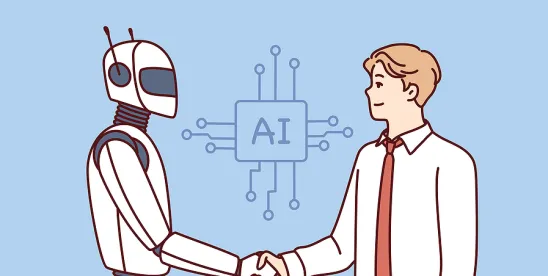The rapid rise of artificial intelligence (AI) has opened up exciting possibilities for innovation, but also uncertainty around who gets credit for inventions developed with the assistance of an AI system. At its core, there lies a fundamental question: who can be named as an inventor on a patent for an AI-assisted invention? In 2022, the U.S. Court of Appeals for the Federal Circuit highlighted this uncertainty by upholding the USPTO’s rejection of patent applications that named an AI system, DABUS, as an inventor.
To address this, the U.S. Patent and Trademark Office (USPTO) issued guidance this February clarifying that AI entities, by themselves, cannot be named as inventors. However, the USPTO recognizes that humans working alongside AI can make significant contributions, and these contributions can qualify for inventorship.
The key concept here is the “significant contribution” standard, which has been used for the past 26 years after it was set forth in Pannu v. Iolab Corp., 155 F.3d 1344, 1351 (Fed. Cir. 1998).Despite massive technological advances in the decades since this decision, the Pannu standard still applies to inventorship analyses, including those involving AI. Thus, the purpose of the USPTO’s guidance is to inform the application of the Pannu inventorship standard to present-day scenarios where an AI system may be involved in the inventive process.
What Level of Human Involvement Amounts to a “Significant Contribution”?
For AI-assisted inventions to be patentable, the level of human involvement during the inventive process must satisfy the “significant contribution” standard. In what follows, different levels of human involvement will be explored to understand the practical implications of the standard and pave the way for successfully defending patent applications for AI-assisted inventions.
I. Contributions to the Claimed Inventions
Low involvement (not a significant contribution): In the realm of AI-assisted inventions, minimal human involvement translates to a lack of significant contribution for inventorship purposes. Simply feeding a general problem to an AI system and accepting its output verbatim would not qualify. Likewise, simply implementing the AI’s output into practice, such as building a device or running a test based on the AI’s recommendation, without any modifications would fall short of the inventive step required.
Medium involvement (potentially a significant contribution): The line blurs when human decisions come into play during the reduction to practice. If these decisions go beyond the AI’s suggestions and address specific challenges, they have the potential to be considered significant contributions. For example, the individual can go beyond the AI’s suggestions by modifying the design of an invention. This may involve selecting a specific material to address a weakness in the AI’s output or making strategic changes to improve functionality.
The level of contribution depends on the specifics and often hinges on whether the decision is something a person of ordinary skill in the art would make. For example, selecting a common material for mechanical housing may not amount to a significant contribution. However, if the individual identifies a technical issue with the housing and strategically selects a different material to address the problem, that could be inventive.
High involvement (a significant contribution): The key here is recognizing a technical issue and making targeted modifications to solve it. Beyond material selection, other types of modifications could also demonstrate significant contributions. This could include recognizing deficiencies in the AI-generated design and modifying it through experimentation, be it altering the component’s shape, relocating parts within it, or developing entirely new parts.
The principle of significant contribution through modification extends to other technical fields. For example, in developing a chemical compound, an individual can use an AI system to generate candidate compounds. If the individual then synthesizes, tests, and – importantly – refines these compounds to arrive at the final product, that hands-on approach would likely demonstrate a significant contribution and therefore patentable human inventorship. Moreover, modifying the structures of the generated compounds during experimentation could be considered a significant contribution.
II. Contributions to the Development of the AI System Used During the Inventive Process
In addition to contributions during invention, there is typically at least one individual who develops, trains, or supervises the AI system used. The level of contribution to the AI’s development can also influence inventorship.
Low involvement (not a significant contribution): Simply supervising or maintaining an AI system during the inventive process would not constitute a significant contribution. Developing a general-purpose AI system without a specific problem in mind would not qualify either.
Medium involvement (potentially a significant contribution): There are instances where the individual who developed the AI could be listed as an inventor. For this to happen, the development and training of the AI system must be in response to, and specifically tailored to, solving a well-defined technical problem. The specific nature of the problem being addressed plays a role here – a more general problem definition could create a gray area for inventorship.
High involvement (a significant contribution): Consider the example of developing a new chemical compound. If the individual faces challenges during experimentation and, in response, creates and trains an AI system specifically designed to optimize compound structures based on a set of desired properties, such development and training could be considered significant contributions to the invention.
Conclusion: Documentation and Policies are Key
The “significant contribution” standard is paramount for practitioners and applicants navigating AI-assisted inventorship. To minimize inventorship challenges, detailed documentation is important. This documentation should capture the methodology, modifications, and experimentation undertaken by individuals throughout the inventive process, especially when AI systems are involved. Remember: the focus on inventive steps that address the specific technical challenge, not just general involvement, is what ultimately leads to a successful claim of inventorship.
While failure to follow these guidelines could result in the denial of patent rights, compliance allows innovators to leverage AI to solve a technical problem while maintaining space for a significant human contribution. This enables the procurement of valuable patents, with a proper human inventor, that are built to survive an inventorship challenge and can then be used to achieve specific business objectives. Accordingly, technology companies would be well suited to put policies in place that align with the USPTO guidelines in order to achieve appropriate protection for their AI-assisted innovations.





 />i
/>i
